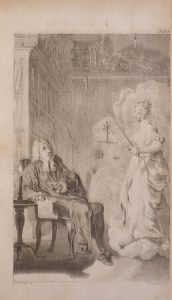Thursday, January 14th
First Day of Class
**
Tuesday, January 19th: Your first writing prompt is due today. Daily assignments can be found under Tools > Assignments on our eLC page.
Attitudes toward the education, duties, and capabilities of women in the eighteenth century
1699, John Locke, selections from Some Thoughts Concerning Education (pdf)
1st published in 1744 as Fables for the Female Sex, and frequently republished), Edward Moore, selections from The Female Sex (pub. 1806). This is an extraordinarily long poem. Please just read the first 26 lines (up to the first illustration) and Fable XV: “The Female Seducers.” Do browse the poem to look at the illustrations. You are reading this poem to get a sense of tropes and imagery associated with feminine virtue in the period.
1750, Johnson, [On Fiction], from Rambler, No. 4 .pdf
1754, [John Hill], from On the Management and Education of Children, A Series of Letters Written to a Neice; By the Honourable Juliana-Susannah Seymour (Burney, Evelina 600-601)
1757, Edmund Burke, “On Delicacy” from A Philosophical Enquiry into the Origin of our Ideas of the Sublime and the Beautiful (Smith, Emmeline 488-489)
1761, Lady Sarah Pennington, from An Unfortunate Mother’s Advice to Her Absent Daughters; In a Letter to Miss Pennington (Burney, Evelina 621-627)
1773, Hester Chapone, “On Politeness and Accomplishments” from Letters on the Improvement of the Mind, Addressed to a Young Lady (Smith, Emmeline 489-491)
1774, John Gregory, from A Father’s Legacy to His Daughters (Smith, Emmeline 491-497)
Writing prompt for today’s class: Choose two of the assigned excerpts for today and put them in conversation with each other. You can choose excerpts on the same subject or on a different subject. In order to receive full credit, you must provide specific textual evidence in support of your assertions.
Please submit your assignment using our eLC site (Tools>Assignment> Tuesday, January 19th, Writing Prompt)
Thursday, January 21st
Excerpts on narrative techniques: James Wood, from How Fiction Works (pdf), Jonathan Culler, from Literary Theory: a very short introduction, “Narrative” (pdf), and class notes (pdf)
List five vocabulary terms/phrases associated with the study of narrative, and then provide definitions. You will almost certainly know the meaning of some of the vocabulary used in the reading for today but you should also choose new vocabulary as well. Submit your response in eLC.
Step 1 of “Who is the late Eighteenth-Century Woman?”
**
Tuesday, January 26th
Frances Burney, Evelina (Volume I; 89-242)
ODNB on Burney. You will need to login to libs.uga.edu and the Oxford Dictionary of National Biography database in order to access this link.
An “epistolary novel” is “a novel whose plot is entirely developed through letters, whether through an exchange of letters between multiple characters or through the correspondence of only one character. The form has been employed for the immediacy it lends the narrative (that is, events are recounted just after — and occasionally even during — the moment of their occurrence) as well as the opportunity it provides to reveal the intimate, private thought s of characters” (The Bedford Glossary of Literary Terms 110)
Weekly Writing Assigment: Evelina begins not with a letter written by the heroine, but rather by an exchange of letters between Lady Howard and the Reverend Villars. How do these letters prepare the reader for Evelina’s “entrance” into the text on pg. 113? What does the reader learn about Evelina from her own point-of-view, once we receive it?
Links for class discussion: “Place in Frances Burney’s Evelina”and more links
Thursday, January 28th
Frances Burney, Evelina (Volume II; 245-357, through Volume II, Letter XX)
In-class writing: Choose one scene from the second volume (through Letter XX) that expands or develops a scene or set of scenes from earlier in the novel.
Does the accretion of similar scenes develop plot, or does it serve a discursive project. In other words, how does repetition change the effect of a plot point?
Homepage, February Schedule, March Schedule, April and May Schedule

